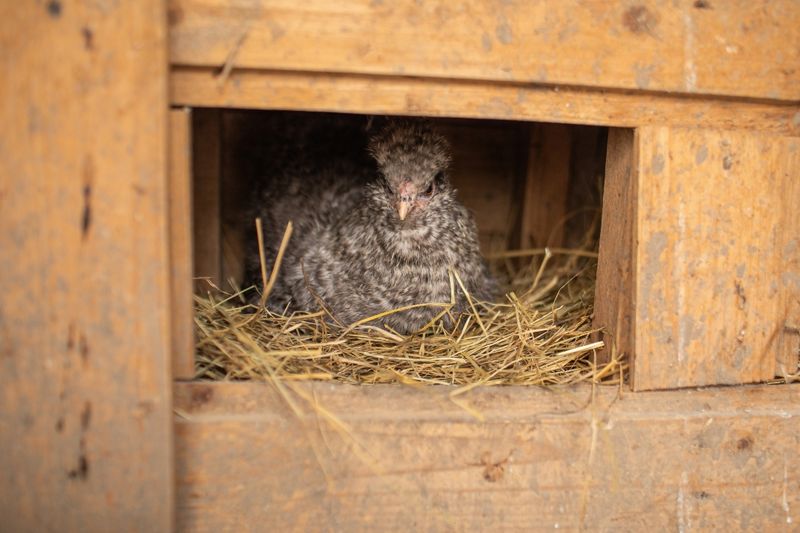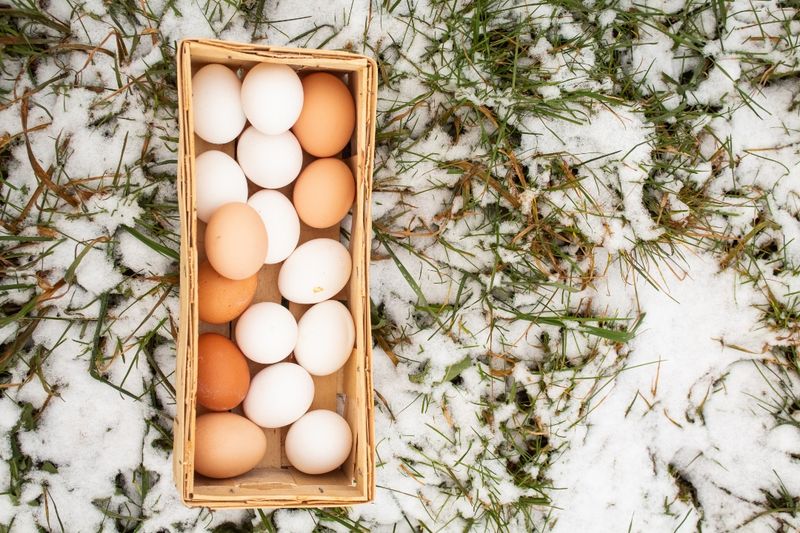Winter Egg Laying Challenges
Tips for a Productive Winter


As the days grow shorter, many chicken keepers notice a significant slowdown in their coop's productivity. The once-dependable daily egg count dwindles, leaving you to wonder if your hens have gone on an extended vacation. This seasonal decline in egg laying is a natural response to the arrival of winter. However, with a deeper understanding of what your flock needs, you can take practical steps to keep the nesting boxes full.
Generally, several factors throughout the year can influence egg production and winter presents its own set of challenges. Factors that may impact egg laying throughout the year include:
- Breed
- Day Length
- Molting
- Broodiness
- Obesity
- Stress
- Temperature
- Nutrition
Winter Egg Production: 4 Key Factors
A hen's ability to lay eggs is closely tied to her environment. Four main factors contribute to the winter slowdown: reduced daylight, colder temperatures, molting and increased stress.
Reduced Daylight Hours
The most significant factor influencing a hen's laying cycle is the amount of daylight she receives. A hen's reproductive system is stimulated by light, which triggers the pituitary gland to produce the hormones necessary for egg formation. For consistent laying, most hens require about 14 to 16 hours of daylight.
You can choose to trick your chickens into thinking the season remains right for reproduction by using lights to compensate for decreasing amounts of natural daylight.
When autumn arrives and the days shorten to less than 12 hours, their bodies naturally signal that it's time to rest and conserve energy for the winter ahead.
Molting
Shorter day lengths signal to chickens that it's time to renew their plumage and molt in preparation for the colder months. Under natural circumstances, a chicken molts during late summer and early fall. During a molt, nutrients needed to produce eggs are channeled into producing feathers. As a result, most hens slow down or stop laying altogether until the molt is complete.
Colder Temperatures
Keeping warm requires a tremendous amount of energy. As temperatures drop, your hens must divert more of their body's resources, particularly calories and nutrients from their feed, toward maintaining their core body temperature. This leaves fewer resources available for other functions, including egg production.
According to Dr. Nancy Jefferson, a backyard poultry expert at Kalmbach Feeds, “The proper amount of day length is arguably the most important factor. However, lighting alone won’t keep your birds at peak egg production. If it’s very cold outside, your hens will need to use lots of nutrients to help keep themselves warm. This will leave fewer nutrients available for egg production.” Essentially, your flock must choose between laying an egg and staying warm and survival always comes first.
Stress Factors
Winter can be a stressful time for a flock. Environmental changes, such as drafts, can negatively affect their well-being. The threat of predators may also increase as other food sources become scarce. This heightened stress can disrupt a hen's hormonal balance and cause egg production to halt altogether. Plus, a chicken’s life is inherently stressful!

Tips for Maintaining or Boosting Egg Production
While you cannot change the seasons, you can adjust your management practices to counteract winter's effects on your flock. By focusing on light, diet and stress reduction, you can encourage your hens to continue laying.
Increasing Light Exposure
To simulate the longer days of spring and summer, you can add supplemental light to your coop. The goal is to provide a consistent 14 to 16 hours of light per day. It is best to add the extra light in the morning rather than the evening. This ensures that as the artificial light turns off, the sun is still out, preventing the hens from being plunged into sudden darkness and struggling to find their roosts. A simple timer can automate this process, creating a reliable schedule.
Dietary Adjustments
Because hens use more energy to stay warm in winter, adjusting their diet is crucial. Switch to a higher-protein layer feed (around 16% to 18% protein) to give them the extra fuel they need. You can also offer scratch grains in the late afternoon as a treat. The process of digesting whole grains creates metabolic heat, helping them stay warmer through the night.
Ensuring your flock has access to fresh, unfrozen water is just as important. Hens will not eat if they cannot drink, so consider using a heated waterer to prevent their water from freezing.
Some flock owners also use natural supplements to bolster their chickens' health. Richard Robbins, owner of an 11-acre homestead, shared his method with AcreageLife, “We added oregano and chlorine dioxide to their water, which supported their immune systems and kept them resilient during colder, stress-filled months. A healthy chicken is a productive chicken.”
Managing Stress Levels
A comfortable and secure coop is essential for reducing flock stress. Make sure the coop is well-ventilated to prevent moisture buildup but free of drafts. Provide a thick layer of clean, dry bedding such as straw to help insulate the floor. Ensure your birds have enough space to move around comfortably, even if they are spending more time indoors. Predator-proofing the coop and run will also give your flock a sense of security.
Should You Use Artificial Lighting?
The decision to use artificial lighting is a personal one, with valid arguments on both sides. Understanding the pros and cons can help you make the best choice for your flock.
Don’t be tempted to leave the coop lights on all the time. It doesn’t give them the 6 to 9 hours of rest per 24 hours they need to maintain a healthy immune system.
Benefits of Artificial Lighting
The primary benefit is clear: a steady supply of eggs throughout the winter. For those who rely on eggs for their family or for income, this consistent production can be a significant advantage. It allows you to maintain your routine without a months-long interruption.
Drawbacks of Artificial Lighting
Critics of artificial lighting argue that it pushes hens beyond their natural cycle. A winter break allows a hen's reproductive system to rest and rejuvenate, which may contribute to a longer, healthier laying life. Forcing production year-round could potentially lead to burnout or other health issues. There is also the added cost of electricity and the need to ensure the lighting set up is safe to prevent fire hazards in the coop.
Best Practices for Using Artificial Lighting
If you decide to use supplemental lighting, introduce it gradually.
Start by adding 30 to 60 minutes of light and increase it incrementally over a two week period until you reach your target of 14 to 16 hours. Continue the lighting program throughout the winter and into spring, until natural daylight is back up to 14 hours.
A low-wattage bulb is all that is needed; you are aiming for the brightness of a dimly lit room, not a stadium.
Maintaining egg production during the winter is a balancing act. By providing supplemental light, adjusting their diet to meet higher energy needs and creating a low-stress environment, you can encourage your hens to continue laying through the colder months.
Ultimately, you must decide whether to push for production or allow your flock a natural winter rest. There is no right or wrong answer. By balancing the desire for fresh eggs with the overall well-being of your flock, you can ensure they remain healthy and happy. For advice tailored to your specific climate and conditions, always consider consulting with local poultry experts or your agricultural extension office.

Additional Winter Care Tips
Beyond the key areas of light and nutrition, a few extra measures can make a big difference in your flock's well-being.
- Keep the Coop Warm and Ventilated: While you want to eliminate drafts, do not seal the coop completely. Proper ventilation, especially near the ceiling, is crucial for allowing ammonia and moisture to escape, preventing respiratory issues and frostbite.
- Provide Enrichment: Boredom can lead to feather-picking and other bad habits. Hang a head of cabbage, offer a flock block or add a few logs for them to perch on to keep them occupied on days they cannot go outside.
- Monitor Flock Health: Spend time observing your chickens daily. Look for signs of illness or distress, such as lethargy, pale combs or changes in droppings. Winter is a time when their immune systems are under more strain, so early detection of problems is key.
Tags:Poultry Lifestyle

Acreage Life is part of the Catalyst Communications Network publication family.
















